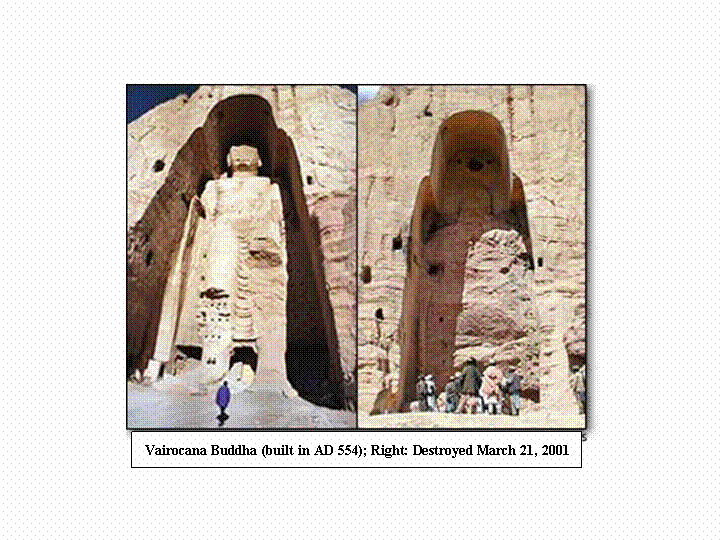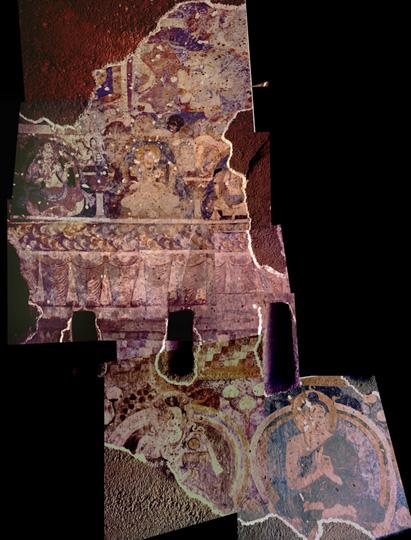
THE DESTRUCTION OF AFGHAN CULTURAL TREASURES
By Nick Gier
Go to www.class.uidaho.edu/ngier/Bamiyan.htm to see images

Eight years ago this month the Taliban demolished two giant Buddha statues in Afghanistan's Bamiyan Valley, 131 miles northwest of Kabul. The international community condemned the act, and the 57-member Organization of the Islamic Conference joined in the outrage. Initially, Mohammed Omar, the Taliban leader, promised that he would preserve the monuments, the largest standing Buddhas in the world (one 174 feet; the other 125 feet). Omar was overruled by radical clerics who insisted that the statues were religious idols and had to be destroyed under Islamic law.
Alexander the Great left administrators and artists in the wake of his conquests in this region then known as Bactria. It was the descendants of Greek artists who convinced their Buddhist students to violate their guru's prohibition of depicting his face. (All that previous artists dared render was his feet!) The result was the stunning Gandhara school of Buddhist art, distinctive for the deep Greco-Roman folds in the clothing.
 During
the 7th Century AD the
Bamiyan Valley was home to ten monasteries and over 1,000 monks. Many of the
monks lived as hermits in caves in the cliffs where the statues were chiseled
out of solid rock. The elaborate cave art is the first ever painted with oils,
six centuries before Europeans perfected this medium.
During
the 7th Century AD the
Bamiyan Valley was home to ten monasteries and over 1,000 monks. Many of the
monks lived as hermits in caves in the cliffs where the statues were chiseled
out of solid rock. The elaborate cave art is the first ever painted with oils,
six centuries before Europeans perfected this medium.
In the 11th Century Muslim armies on their way to conquer India tried to destroy the statues, but they did not have the technology to do it. The artillery of the Nadar Shah (1698-1744), sometimes known as the Persian Napoleon, did damage them, but could not bring them down. The Taliban bombarded and dynamited the cliffs for a month before the deed was done.
Before the Taliban came to power in 1996, the National Museum in Kabul, built by King Amanullah in 1922, had already been destroyed by other mujahideen. Thousands of artifacts were sold on the black market with Pakistan (Peshawar in particular) serving as a transhipment point. On August 6, 1995 the Pakistani government appropriated 30 million rupees to buy up these items, and there is no doubt that many of them were resold at a profit, in obvious violation of international law, to private dealers.
Last November I saw the Bactrian Gold exhibit at the Asian Art Museum in San Francisco. It was once feared that these incredible treasures, intricate gold necklaces, bowls, and amulets from 2,200 BC to 200 AD, had either been taken off to Moscow by the Soviets during their invasion of the 19780s or had been melted down by jihadists to buy arms. It turned out that director of the Kabul Museum had secretly sealed them in a vault in the Central Bank in 1989. The safe was drilled opened in 2004 and the Bactrian Gold is now on a triumphant world tour. The new government in Kabul sees this as a chance to reposition Afghanistan as the seat of great civilizations rather than a country known for opium production and radical Muslims.
There were Buddhist centers of learning in ancient Pakistan, and, although the modern nation is 95 percent Muslim, the government has proudly preserved its Buddhist heritage. The current regime, however, has allowed the Taliban to impose shari'ah law in the Swat Valley, and a museum for Buddhist artifacts was recently bombed by Muslim militants and 150 objects were destroyed.
With all this in mind, I am really torn about our current policy in Afghanistan and Pakistan. With President Obama giving the orders, Predator drones are killing more and more Taliban and Al Qaeda leaders and innocent bystanders in Western Pakistan. The current government in Islamabad is teetering on collapse from internal political fighting as well as increased support for militant Islam, mainly due to U.S. interference.
In Afghanistan the Taliban has increased their control of the country from 50 percent in 2007 to 70 percent last year. Kabul is now essentially surrounded and militant attacks in the city have increased 35 percent over 2007. The Bush administration ignored Afghanistan to pursue the invasion of Iraq, so reconstruction efforts have faltered. Kabul has only a few hours of electricity each day and the Kabul-Kandahar road, opened with must fanfare in 2003, has been described as a "suicide route for anyone driving with a security detail."
President Obama has sent 17,000 more Marines to Afghanistan, even when he himself knows that military force alone will not solve the problems. In fact, a greater military presence will lead to more civilian casualties. The UN has now confirmed that 90 civilians (including 60 children) were killed in Herat province on August 26, 2008. Civilian deaths were up 40 percent from those in 2007, one half caused by coalition forces. The Campaign for Innocent Victims in Conflict declares that coalition forces are "losing public support one fallen civilian at a time."
Retired Army colonel Andrew Bacevich: "Afghanistan will be a sinkhole, consuming resources neither the U.S. military nor the U.S. government can afford to waste." According to standard calculations from counter-insurgency theory, it would require 600,000 troops to quell the Taliban insurgency. As long as the Taliban can cross the border and find refuge in Pakistan, no amount of troops in Afghanistan will do the job. Compared to nearly 500,000 fairly well trained troops in Iraq with 28 million people, the 76,000 poorly trained Afghan troops are little help to the 51,300 coalition forces in a country of 33 million.
The Obama administration has said that it is open to the possibility of a negotiated settlement with the Taliban. The problem with a diplomatic solution is whether or not we can trust them, and the experience in the Swat Valley demonstrates that we cannot. I agree with the editors of the New York Times: "We are deeply skeptical that there is any deal to be cut with the Taliban leaders, who . . . would undoubtedly insist on reimposing their repressive, medieval ways, including denying education and medical care to women." I would simply add the real possibility that the Taliban would finish the destruction of Afghanistan's cultural treasures, and they would definitely block the Japanese and Swiss efforts to reconstruct the Bamiyan Buddhas.